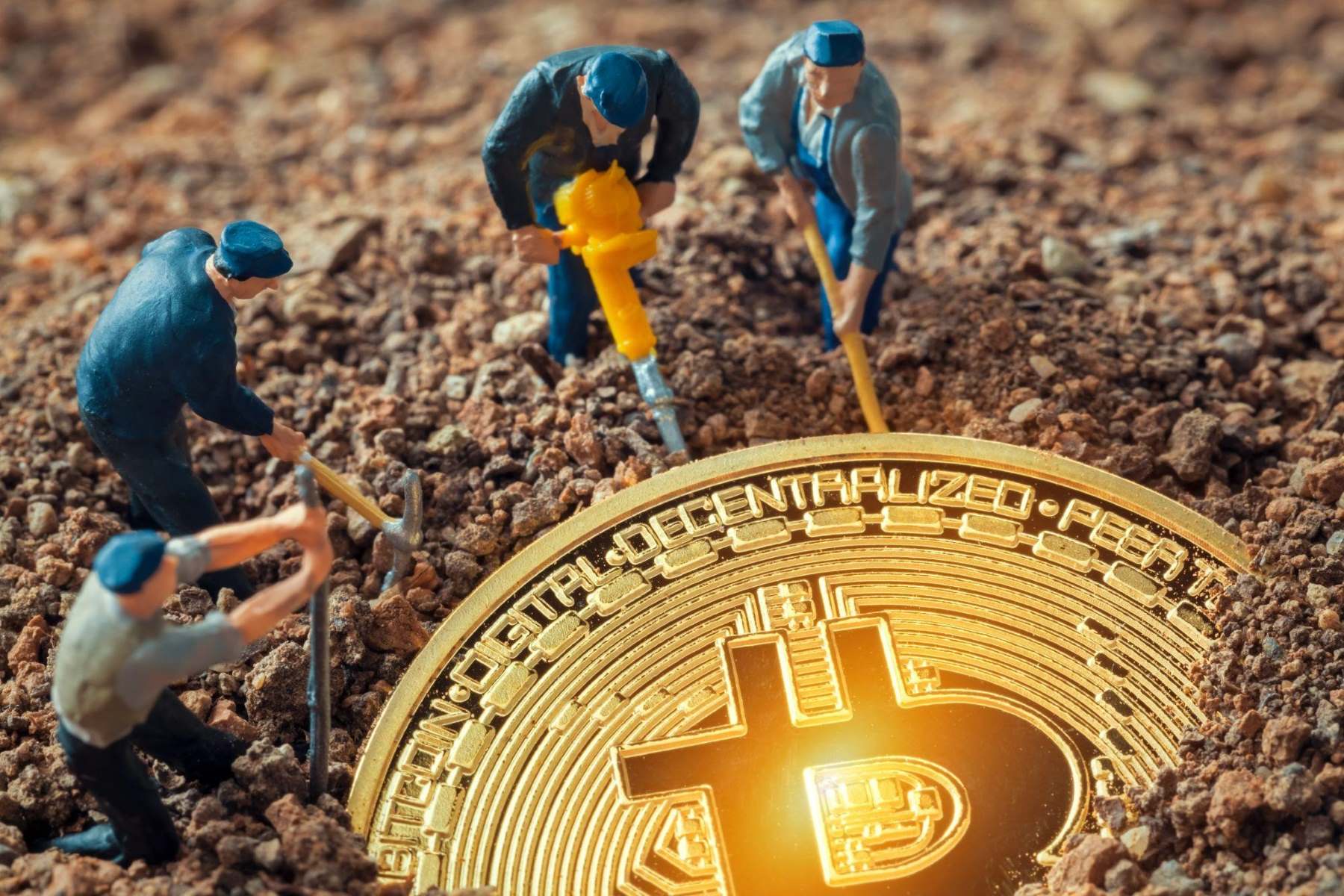Introduction
Cryptocurrency mining has become an increasingly popular activity in recent years, attracting individuals and businesses alike. This process involves verifying and adding transactions to a blockchain network, while being rewarded with new cryptocurrency coins as an incentive. With the rising value of cryptocurrencies, mining has the potential to be a profitable venture.
But what exactly is cryptocurrency mining? In simple terms, it is the process of using powerful computers to solve complex mathematical problems that validate transactions on a blockchain network. These networks are decentralized, meaning they are not controlled by any central authority, such as a government or financial institution. Instead, they rely on a network of miners to verify and secure transactions.
So, why do people engage in cryptocurrency mining? The answer lies in the rewards that miners receive for their efforts. Miners are rewarded with newly minted cryptocurrency coins for successfully solving the complex mathematical problems. These coins can then be sold or held as an investment, potentially leading to substantial profits as the value of the cryptocurrency increases over time. Furthermore, mining can also provide a sense of contributing to the underlying technology and decentralization of the cryptocurrency ecosystem.
However, before diving into the world of cryptocurrency mining, it is important to consider several factors. First and foremost, one must evaluate the cost of mining equipment, electricity consumption, and the overall profitability of mining. The mining process can be resource-intensive, requiring specialized hardware called mining rigs and consuming significant amounts of electricity. It is crucial to calculate the potential returns and determine if the investment is worthwhile.
Another important aspect to consider is the chosen cryptocurrency to mine. With hundreds of different cryptocurrencies available, each with its unique blockchain and mining algorithm, selecting the right one is crucial. Factors to consider include the current market value, mining difficulty, potential for future growth, and availability of mining pools for that specific cryptocurrency.
In the following sections, we will explore some of the popular cryptocurrencies for mining, including Ethereum, Bitcoin, Monero, Litecoin, and Dogecoin. Each has its own advantages and considerations, making them suitable for different types of miners and investment goals.
What is cryptocurrency mining?
Cryptocurrency mining is the essential process of validating and recording transactions on a blockchain network. It involves using powerful computers to solve complex mathematical problems, which verify the legitimacy of transactions and add them to the blockchain ledger. Miners are rewarded with new cryptocurrency coins for their contribution to this process.
At the core of cryptocurrency mining is the concept of a blockchain. A blockchain is a decentralized digital ledger that records all transactions made within a particular cryptocurrency network. This ledger is maintained and updated by a network of computers, known as nodes, which communicate and reach a consensus on the validity of each transaction.
When a cryptocurrency transaction occurs, it is broadcasted to the network and awaits confirmation. This is where miners come into play. Miners collect groups of pending transactions called blocks and compete to solve a complex mathematical problem, known as a hash function. The first miner to solve the problem broadcasts their solution to the network, which is then validated by other miners. If the solution is accepted, the block of transactions is added to the blockchain, and the miner is rewarded with newly minted cryptocurrency coins.
The mathematical problems that miners must solve are deliberately designed to be computationally challenging. This ensures that the process of adding new blocks is not too rapid and provides security to the blockchain network. As the number of miners increases, the difficulty of the mathematical problem adjusts accordingly to maintain a predictable block creation rate.
It’s important to note that cryptocurrency mining requires specialized hardware and software. Miners use powerful computer systems specifically designed for mining, called mining rigs or ASICs (Application-Specific Integrated Circuits). These rigs are equipped with high-performance graphics processing units (GPUs) or ASIC chips, which are optimized for the hash functions used by the specific cryptocurrency network.
Furthermore, mining also requires a significant amount of electricity to power the mining rigs. The computational power required to solve the mathematical problems consumes a substantial amount of energy, leading to high electricity bills for miners. Hence, the cost of electricity is an important consideration when determining the profitability of mining.
Cryptocurrency mining plays a crucial role in maintaining the stability, security, and integrity of blockchain networks. By verifying transactions and adding them to the blockchain, miners contribute to the decentralization and trustworthiness of the cryptocurrency ecosystem. Mining not only provides an avenue for individuals to earn cryptocurrency rewards but also supports the overall functioning of the blockchain technology.
Why mine cryptocurrency?
Cryptocurrency mining offers several compelling reasons for individuals and businesses to participate in the process. Here are some key benefits of mining cryptocurrency:
Potential for Profit: One of the primary motivations for mining cryptocurrency is the potential for profit. As a miner, you have the opportunity to earn new cryptocurrency coins as a reward for your mining efforts. If the value of the cryptocurrency increases over time, the coins you mine could appreciate in value, leading to a significant return on investment.
Supporting the Network: Mining plays a vital role in maintaining the integrity and security of blockchain networks. By participating in mining, you contribute to the decentralized nature of cryptocurrency networks and help verify and validate transactions. This support ensures the continued functioning and stability of the network.
Opportunity for Passive Income: Once you have set up your mining operation, it has the potential to generate passive income. As long as your mining hardware is running and connected to the network, you can continue to earn rewards for verifying transactions. This allows for a source of income that does not require active involvement.
Decentralized Finance (DeFi): Cryptocurrency mining aligns with the principles of decentralized finance (DeFi), which aims to democratize financial systems and remove intermediaries. By participating in mining, you become an integral part of the decentralized network, contributing to its overall security and operation.
Investment Diversification: Mining cryptocurrency provides an alternative investment avenue, diversifying your portfolio. By mining different cryptocurrencies, you can spread your risk across various digital assets. Additionally, by accumulating new coins through mining, you can hold onto them as a long-term investment strategy.
Technological Advancement: Engaging in cryptocurrency mining allows you to stay at the forefront of technological advancements. Mining requires specialized hardware and software configurations, leading to a deeper understanding of computer systems and blockchain technology. This knowledge can be valuable in various industries and future technology developments.
Participating in a Community: The mining community is vibrant and active, offering opportunities for collaboration and networking. By joining mining pools or online forums, you can connect with fellow miners, exchange insights, gain valuable knowledge, and stay up-to-date with the latest developments in the cryptocurrency mining ecosystem.
Financial Freedom: Cryptocurrency mining provides the potential for financial freedom and independence. By earning cryptocurrency through mining, you can secure your financial future and have control over your assets. This decentralized nature allows for borderless transactions and financial empowerment.
In summary, mining cryptocurrency presents an array of benefits, including the potential for profit, supporting the network, passive income, investment diversification, technological advancement, community participation, and financial freedom. It is essential to evaluate the costs, risks, and potential rewards before embarking on the mining journey, but for many, the rewards outweigh the challenges.
Factors to Consider Before Choosing a Cryptocurrency to Mine
Before diving into cryptocurrency mining, it is essential to carefully evaluate various factors that can impact your mining experience and profitability. Here are some key considerations to keep in mind when choosing a cryptocurrency to mine:
Market Value: The current market value of a cryptocurrency is an important factor to consider. Higher-valued cryptocurrencies may provide greater potential rewards for successful mining. However, they may also have higher mining difficulty levels or require significant investments in mining equipment and electricity.
Mining Difficulty: Mining difficulty refers to the complexity of the mathematical problems miners need to solve to validate transactions. Higher mining difficulty implies a greater computational effort required to mine new coins successfully. Consider the balance between difficulty and potential rewards to ensure a profitable mining experience.
Potential for Future Growth: Assessing the potential for future growth of a cryptocurrency is crucial. Look for cryptocurrencies with strong development teams, active communities, and promising roadmaps. Understanding the technology and potential market adoption can help gauge the future value and demand for the cryptocurrency.
Availability of Mining Pools: Mining pools allow multiple miners to combine their computational power, increasing the chances of successfully mining blocks. Before choosing a cryptocurrency to mine, check the availability of well-established mining pools for that specific cryptocurrency. Joining a mining pool can provide a more consistent income stream and reduce the impact of mining difficulties.
Electricity Costs: Mining requires a significant amount of electricity to power the mining rigs. High electricity costs can greatly impact the profitability of mining, particularly in regions where electricity prices are high. Consider your access to cost-effective electricity options or renewable energy sources to minimize operational expenses.
Hardware and Technical Requirements: Different cryptocurrencies have unique hardware requirements. Some cryptocurrencies are better suited for GPU mining, which relies on high-performance graphics cards, while others require specialized ASIC mining rigs. Assess the availability and cost of the required hardware and ensure your technical expertise aligns with the chosen cryptocurrency’s mining process.
Network Security: Consider the security of the cryptocurrency network you intend to mine. Review the history of any major security incidents or vulnerabilities, as they can affect the reputation and stability of the cryptocurrency. A secure network is essential to protect your mining operations and the value of the mined coins.
Regulatory Environment: Cryptocurrency regulations vary across different jurisdictions. Stay informed about the legal and regulatory landscape surrounding cryptocurrencies in your country. Compliance with regulations can impact the legality and profitability of your mining activities.
Personal Interest: Lastly, consider your personal interest and passion for the cryptocurrency you plan to mine. Engaging in mining can involve a significant investment of time, effort, and resources. Being interested in the technology and the vision behind the cryptocurrency can sustain your motivation throughout the mining journey.
By considering these factors and conducting thorough research, you can make an informed decision when choosing a cryptocurrency to mine. Keep in mind that the cryptocurrency landscape is dynamic, and market conditions can change rapidly. Regularly reassess your mining strategy to adjust for profitability, market trends, and new opportunities that may arise.
Popular Cryptocurrencies for Mining
When it comes to mining cryptocurrencies, several options have gained popularity due to their potential profitability, robust networks, and active communities. Here are five popular cryptocurrencies for mining:
Ethereum
Ethereum is a decentralized blockchain platform that enables the development of smart contracts and decentralized applications (DApps). Ethereum mining is primarily done using GPUs, making it accessible to a broader range of miners compared to ASIC-based mining. The cryptocurrency, Ether (ETH), has a significant market value and a promising future, making it a preferred choice for many miners.
Bitcoin
Bitcoin is the pioneer and most well-known cryptocurrency in the market. Bitcoin mining, however, has become highly competitive and resource-intensive. It requires specialized hardware known as ASICs, which are designed specifically for Bitcoin’s hashing algorithm. While the mining difficulty has increased over the years, the potential rewards and the value of Bitcoin provide an incentive for dedicated miners.
Monero
Monero is a privacy-focused cryptocurrency that provides enhanced security and anonymity. Monero mining can be done using CPUs and GPUs, allowing a broader range of miners to participate. The algorithm used by Monero, called RandomX, is designed to be resistant to ASIC mining, providing a more level playing field for miners. The strong focus on privacy has made Monero a popular choice among individuals who value confidentiality.
Litecoin
Litecoin, often referred to as the “silver to Bitcoin’s gold,” was created to offer faster transaction confirmations and a more efficient mining process. Litecoin uses a different hashing algorithm called Scrypt, which is ASIC-resistant and allows for CPU and GPU mining. The popularity of Litecoin stems from its active development community and its relatively low mining difficulty compared to Bitcoin.
Dogecoin
Originally started as a meme cryptocurrency, Dogecoin has gained a substantial following and has become a viable option for mining. Dogecoin utilizes the Scrypt algorithm, enabling mining with CPUs and GPUs. The community-driven nature of Dogecoin, along with its active online community and charitable initiatives, has contributed to its enduring popularity among miners.
Keep in mind that the mining landscape is constantly evolving, and the profitability of mining specific cryptocurrencies can vary over time. It is essential to evaluate the market conditions, mining difficulty, and potential rewards before deciding on a cryptocurrency to mine. Additionally, staying updated with the latest news and developments in the cryptocurrency space can help identify emerging cryptocurrencies that may offer mining opportunities.
Ethereum
Ethereum is a decentralized blockchain platform that has been gaining significant attention in the world of cryptocurrency mining. Created by Vitalik Buterin in 2015, Ethereum’s main purpose is to facilitate the development of decentralized applications (DApps) and smart contracts. However, Ethereum’s native cryptocurrency, Ether (ETH), has become a popular choice for miners due to its potential profitability and widespread adoption.
Ethereum mining primarily involves using graphics processing units (GPUs), making it accessible to a broader range of miners compared to ASIC-based mining. The mining process involves solving complex mathematical problems to validate transactions and add new blocks to the Ethereum blockchain. Miners are rewarded with Ether for their computational efforts.
One of the key advantages of mining Ethereum is its market value. Ethereum has consistently ranked among the top cryptocurrencies in terms of market capitalization, making it an attractive option for miners seeking potential profits. Moreover, Ethereum’s popularity within the crypto community and its strong network effect contribute to its stability and long-term viability.
Another notable aspect of Ethereum mining is its potential for future growth. Ethereum is constantly evolving and introducing upgrades to enhance its scalability and efficiency. The upcoming Ethereum 2.0 upgrade, which involves transitioning to a proof-of-stake (PoS) consensus mechanism, is expected to make mining more energy-efficient and accessible to a wider range of participants.
However, Ethereum mining does come with certain challenges. As the Ethereum network has grown in popularity, the mining difficulty has increased significantly. This means that it requires substantial computational power and electricity to mine Ether successfully. Miners often join mining pools to combine their resources and increase their chances of earning rewards.
Furthermore, Ethereum’s transition to Ethereum 2.0 introduces uncertainties for miners. With the shift to PoS, the role of traditional GPU mining may diminish, and miners may need to explore alternative ways to contribute to the network and earn rewards. This transition also highlights the importance of staying updated with Ethereum’s development roadmap and understanding the potential impact on mining operations.
Despite the challenges, Ethereum mining continues to attract miners due to its potential profitability, strong community support, and the overall potential for growth in the decentralized applications space. It is important for miners to stay informed about changes in Ethereum’s ecosystem to adapt their mining strategies accordingly.
In summary, Ethereum mining offers the potential for profitability and participation in the development of a vibrant decentralized ecosystem. It is crucial for miners to consider factors such as market value, mining difficulty, network upgrades, and energy costs when mining Ethereum. By staying informed and adapting to the evolving landscape, miners can maximize their chances of success in the Ethereum mining ecosystem.
Bitcoin
Bitcoin holds the distinction of being the first and most well-known cryptocurrency in the world. Created by an anonymous individual or group using the pseudonym Satoshi Nakamoto, Bitcoin revolutionized the digital currency space and sparked a global movement towards decentralization. Bitcoin mining, in particular, has become a highly competitive and resource-intensive activity.
Bitcoin mining involves the use of specialized hardware known as application-specific integrated circuits (ASICs), which are specifically designed to perform the complex calculations required to validate transactions and secure the Bitcoin network. The mining process consists of solving mathematical problems that allow miners to add new blocks to the blockchain and earn rewards in the form of newly minted bitcoins.
One of the key attractions of Bitcoin mining is the potential for substantial rewards. As one of the most valuable and widely adopted cryptocurrencies, Bitcoin offers the opportunity for significant profits for successful miners. However, it’s essential to consider the high mining difficulty and the substantial investment required in mining equipment and electricity costs.
Bitcoin’s popularity and market dominance have resulted in a highly competitive mining landscape. The difficulty of mining Bitcoin is constantly adjusted to maintain a consistent block creation rate. Miners must stay up to date with the latest mining technologies and optimize their hardware and energy efficiency to remain competitive in the market.
As the number of miners increases, the computational power required to mine Bitcoin has grown exponentially. Consequently, individual miners may find it more challenging to mine Bitcoin alone due to the high costs involved. Many miners join mining pools, where they combine their resources to increase their chances of earning rewards.
Bitcoin mining also plays a crucial role in the security and decentralized nature of the network. By participating in mining, individuals contribute to the validation and verification of transactions, ensuring the integrity of the blockchain. Mining adds an additional layer of trust and immutability to the Bitcoin network, making it resistant to attacks or manipulation by any single entity.
It’s essential to note that the Bitcoin mining landscape is constantly evolving. The upcoming Bitcoin halving events, which occur approximately every four years and reduce the block reward by half, introduce additional complexities and potential rewards for miners. Staying informed about these events and anticipating market trends is vital for miners seeking to maximize their profitability.
In summary, Bitcoin mining represents a highly competitive but potentially lucrative endeavor. It requires specialized hardware, a significant investment in electricity, and a comprehensive understanding of the market conditions. As the backbone of the Bitcoin network, mining contributes to the security, decentralization, and trustworthiness of the world’s most prominent cryptocurrency.
Monero
Monero is a privacy-centric cryptocurrency that has gained significant traction in the crypto community. Created in 2014, Monero focuses on privacy and security by offering untraceable transactions and anonymous addresses. Monero’s mining algorithm, known as RandomX, is designed to be resistant to ASIC mining, allowing for a more level playing field for miners using CPUs and GPUs.
Monero mining involves the process of solving complex mathematical problems to validate transactions and add new blocks to the Monero blockchain. Miners who successfully contribute computational power to the network are rewarded with newly minted Monero coins.
One of the key advantages of mining Monero is its focus on privacy. Monero utilizes advanced cryptography techniques, such as ring signatures and stealth addresses, to ensure the anonymity of transactions. This privacy feature has made Monero a preferred choice for individuals who value confidentiality in their financial transactions.
Unlike Bitcoin, Monero’s mining algorithm was designed to resist ASIC mining hardware, which provides a more egalitarian mining experience for participants. This allows miners with consumer-grade CPUs and GPUs to effectively mine Monero without the need for specialized and costly equipment.
Monero’s commitment to privacy and security, combined with its active development community, has contributed to its popularity among miners. The strong community support has led to continuous improvements in Monero’s protocol, ensuring its resilience against potential attacks and keeping miners involved in the network.
However, it is worth noting that Monero mining can be resource-intensive. The mining process requires significant computational power and electricity consumption. As a result, it is essential for miners to carefully consider the costs associated with mining, including the initial investment in hardware and ongoing electricity expenses.
Joining a mining pool is a common strategy for Monero miners, as it allows them to combine their computational resources and increase their chances of earning rewards. Pool mining also provides a more consistent income stream compared to solo mining, which can be more uncertain due to the computational power required to successfully mine new blocks.
Overall, Monero mining offers a unique opportunity for individuals to participate in a privacy-focused cryptocurrency ecosystem. The emphasis on anonymity, combined with its resistance to ASIC mining and active community, makes Monero an appealing choice for miners who prioritize privacy and are looking for an alternative to more mainstream cryptocurrencies.
As with any mining activity, it is essential to stay informed about the latest developments and network updates in the Monero ecosystem. This will ensure that miners can adapt their strategies and leverage any new opportunities that may arise, ultimately maximizing their profitability and participation in the Monero mining community.
Litecoin
Litecoin, often referred to as the “silver to Bitcoin’s gold,” is a peer-to-peer cryptocurrency that was created in 2011 by Charlie Lee, a former Google engineer. Litecoin was designed to address some of the perceived limitations of Bitcoin, such as slower transaction times and high fees. Over the years, Litecoin has gained popularity among miners due to its efficient mining process and active community.
Litecoin utilizes a different hashing algorithm called Scrypt, which is designed to be resistant to application-specific integrated circuit (ASIC) mining. This makes it more accessible for miners using consumer-grade hardware, such as CPUs and GPUs, as opposed to specialized mining equipment.
Mining Litecoin involves the process of solving mathematical problems to validate transactions and add new blocks to the Litecoin blockchain. Miners who successfully mine blocks are rewarded with newly minted Litecoins, providing an incentive for individuals to participate in the network and secure the blockchain.
One of the key advantages of mining Litecoin is its relatively low mining difficulty compared to Bitcoin. This means that the computational power required to mine Litecoin is lower, allowing miners to have a higher chance of successfully mining blocks and earning rewards. The lower mining difficulty also makes Litecoin more accessible and beginner-friendly for aspiring miners.
Furthermore, Litecoin boasts faster block generation times compared to Bitcoin, resulting in quicker transaction confirmations. This characteristic has made Litecoin a preferred choice for individuals who require faster transactions or need to move funds in a timely manner.
The strong community support surrounding Litecoin has contributed to its longevity and continuous development. The Litecoin community actively engages in discussions and improvements to ensure the stability and growth of the network. The Litecoin Foundation, a non-profit organization that supports Litecoin’s development and adoption, further adds to the sense of community involvement.
While Litecoin may not have gained the same level of mainstream recognition as Bitcoin, its active community and commitment to innovation have positioned it as a popular choice for mining. As with any cryptocurrency, it is important for miners to research and stay informed about market trends, network developments, and changes in mining difficulty to optimize their mining operations.
Joining a mining pool is a common strategy among Litecoin miners, as it allows them to combine their computational resources and increase their chances of successfully mining blocks. Pool mining offers a more consistent income stream compared to solo mining, which may have more variable results due to the computational power requirements.
In summary, Litecoin offers a compelling option for miners who seek an alternative to Bitcoin. With its efficient Scrypt mining algorithm, active community support, and faster transaction times, Litecoin provides a viable opportunity for individuals looking to participate in cryptocurrency mining without the need for specialized equipment.
Dogecoin
Dogecoin, initially created in 2013 as a joke cryptocurrency, has grown into a popular and widely recognized digital currency. Despite its humble beginnings, Dogecoin has gained a devoted following due to its active community, charitable initiatives, and approachable mining process.
Dogecoin’s mining process is based on the Scrypt algorithm, which allows for mining with both CPUs and GPUs. This feature makes Dogecoin mining more accessible to a broader range of miners, as it doesn’t require specialized ASIC mining equipment.
Mining Dogecoin involves solving complex mathematical problems to validate transactions and add blocks to the Dogecoin blockchain. Miners are rewarded with newly minted Dogecoins for their computational efforts, providing an incentive for individuals to participate in the network and secure the blockchain.
The Dogecoin community is known for its philanthropic efforts and generous nature. Dogecoin has been involved in various charitable initiatives, such as supporting clean water projects, sponsoring sports teams, and assisting in disaster relief efforts. This community-driven aspect has contributed to Dogecoin’s enduring popularity among miners.
Despite its light-hearted origins, Dogecoin has maintained its relevance in the cryptocurrency space. Its active online community fosters engagement, with users often sharing memes and participating in discussions surrounding its development and use cases. This sense of community involvement has played a significant role in the longevity and success of Dogecoin.
One notable aspect of Dogecoin mining is the relative ease of participation. The Scrypt mining algorithm, combined with the widespread availability of CPU and GPU mining hardware, allows for a lower entry barrier compared to cryptocurrencies that require specialized ASICs. This accessibility makes Dogecoin mining an attractive option for newcomers and those looking to engage in cryptocurrency mining without significant upfront expenses.
Joining a mining pool is a common strategy for Dogecoin miners, as it allows them to combine their computational resources with other miners, increasing the chances of successfully mining blocks and earning rewards. Pool mining also provides a more consistent income stream compared to solo mining, which can have more variable results.
Overall, Dogecoin offers a unique and approachable mining experience for individuals interested in participating in the world of cryptocurrencies. With its active community, charitable initiatives, and easy-to-engage mining process, Dogecoin continues to provide a fun and rewarding avenue for miners who seek a lighter side of the crypto world.
Conclusion
Cryptocurrency mining presents individuals with a unique opportunity to participate in the world of digital currencies. By dedicating their computational power and resources, miners contribute to the security, decentralization, and trustworthiness of blockchain networks.
Throughout this article, we explored various aspects of cryptocurrency mining and highlighted popular cryptocurrencies for mining, including Ethereum, Bitcoin, Monero, Litecoin, and Dogecoin.
Each cryptocurrency offers its own advantages and considerations, ranging from potential profits and market value to mining difficulty and community support. Ethereum, with its focus on smart contracts and wide adoption, provides an appealing option for miners. Bitcoin, as the pioneer cryptocurrency, offers potential rewards alongside intense competition. Monero’s focus on privacy attracts those seeking confidentiality in their transactions. Litecoin provides a more accessible mining experience due to its lower mining difficulty compared to Bitcoin. Finally, Dogecoin’s active community and approachable mining process create a fun and engaging environment for miners.
Before embarking on a mining journey, it is crucial to carefully consider factors such as market value, mining difficulty, hardware requirements, electricity costs, and potential network changes. Engaging in thorough research and staying up-to-date with news and developments will allow miners to make informed decisions and adapt their strategies accordingly.
Whether mining for potential profits, supporting decentralization, seeking investment diversification, or being part of a vibrant community, cryptocurrency mining offers a wealth of opportunities. However, it is important to approach mining with realistic expectations, considering the costs and risks involved.
As the cryptocurrency landscape continues to evolve, it is essential for miners to stay well-informed, adapt to changes, and remain flexible in their mining strategies. By doing so, miners can navigate the dynamic nature of the industry and maximize their chances of successful mining experiences.
In conclusion, cryptocurrency mining provides a unique way to engage with digital assets, contribute to blockchain networks, and potentially reap rewards. Each mining journey is as unique as the individual miner, and careful consideration of factors and active participation are key to success in this ever-evolving field.

























